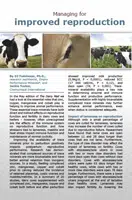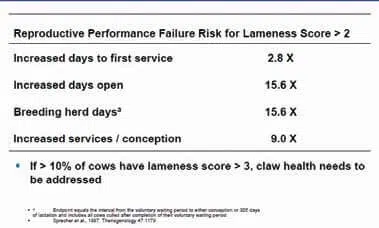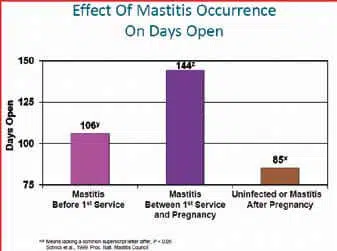In the May edition of the Dairy Mail we had a look at the essential roles that zinc, copper, manganese and cobalt play in helping to improve animal performance. These essential trace minerals have both direct and indirect effects on reproductive function and fertility in dairy cows and heifers, however, often unrecognized are the effects of the immune system on reproductive function and how stressors tied to lameness, mastitis and heat stress impact immune function and maintenance of normal cyclicity.
Improving the availability of trace minerals prior to parturition positively impacts postpartum reproductive performance. Research has demonstrated that complexed sources of trace minerals are more bioavailable and have better animal retention than inorganic sources. In a study, feeding complexed zinc, manganese, copper and cobalt prior to calving reduced incidence of retained placentas, cystic ovaries and mastitis/metritis. In a summary of twenty studies, dairy cows supplemented with complexed zinc, manganese, copper and cobalt both before and after parturition showed improved milk production (0.9 kg/d, P < 0.0001), reduced SCC (17,000 cell/mL, P < 0.12), and days open (7d, P < 0.001). Trace mineral availability plays a key role in determining enzyme and immune function and productive performance. Supplementation with highly bioavailable complexed trace minerals may further enhance animal performance even when status is considered adequate.
Impact of Lameness on Reproduction
Although only about a small percentage of cows are culled for lameness, lameness may increase the number of cows culled due to reproductive failure. Researchers have found that lame cows are open between 11 and 28 days longer than cows that are not lame. Furthermore, the type of claw disorder may affect the impact of lameness on fertility. Cows with abscesses/sole ulcers or cows with two or more claw disorders had more days open than cows without claw disorders. Cows with abscesses/sole ulcers were open 63 days longer than healthy cows, while cows with two or more claw disorders were open 76 days longer. Furthermore, there were a lower percentage of cows with abscesses/sole ulcers pregnant at the end of lactation than healthy cows. Lameness may also impact fertility by lowering the first service conception rates and increase the incidence of ovarian cysts as indicated by results of a University of Florida study. Cows that were clinically lame due to a claw disorder in the first 30 days postpartum had a 58.9% decrease in first service conception rates (P < 0.05), a 125% increase in ovarian cysts and a 8.2% decrease in pregnancy rate at 480 d postpartum. Probably the most noteworthy observation was that 30.8% of cows that were lame during the first 30 days of lactation were culled prior to recording any reproductive event compared to 5.4% of non-lame (control) cows. By using the locomotion scoring system based on back posture of cows both standing and walking is an effective means of assessing potential for reproductive failure. This system identifies cows on a 1 to 5 scale with 1 representing normal healthy animals and 5 as clinically lame. Cows scoring a 3 or greater were 2.8 times more likely to have increased days to first service, 15.6 times more likely to have increased days open and 9.0 times more likely to have increased services per conception. In addition, cows scoring 3 or greater were 8.4 times more likely to be culled (Table 1).
| | |
Table 1: Effect of locomotion score > 2 on reproductive performance (Sprecher et al., 1997) | Figure 1: Effect of mastitis on days open (Schrick et al., 1999) |
Results of these studies indicate that greater lameness severity results in greater economic losses. Early diagnosis of lameness and intervention is essential to minimizing the severity of lameness. Increased stress due to lameness may depress the immune system and therefore the combination of unclean resting surfaces and depressed immune function may lead to higher incidence of mastitis.
Florida research indicates that replacing inorganic forms of zinc, manganese, copper and cobalt with those from Zinpro Performance Minerals, beginning in the dry period and continuing through lactation, reduced incidence and severity of claw disorders. For example, overall incidence of claw disease was decreased by 30.8%, as early as 75 days postpartum with a further reduction by 43.5% by 250 days in milk.
Impact of Mastitis on Reproduction
Mastitis has been implicated in decreasing reproductive performance of dairy cows. Moore et al. (1991) reported a negative correlation between clinical mastitis and reproduction due to altered inter-estrus intervals and decreased length of the luteal phase in cows with clinical mastitis caused by gram-negative mastitis pathogens. University of Tennessee (Table 2) research indicates that mastitis both before 1st service or between 1st service and being confirmed pregnant increased days to 1st service, services/conception and days open.
Chemuniqué empowers feed and food producers with the most innovative animal performance solutions, enabling our clients to consistently advance the efficiency of production.











